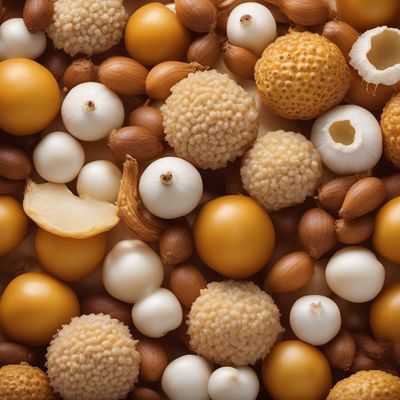
Ingredient
Naranjillas
The Exotic Citrus: Naranjillas
Naranjillas are small, round fruits that resemble oranges or tomatoes. They have a thick, fuzzy skin that turns from green to orange when ripe. The flesh is juicy and contains numerous small seeds. Naranjillas have a unique flavor profile, combining citrusy notes with a hint of tartness and sweetness. The texture is similar to a tomato, with a slightly gelatinous consistency.
Origins and history
Naranjillas have a long history in the Andean region, where they have been cultivated for centuries. They are particularly popular in Ecuador, Colombia, and Peru, where they are used in traditional dishes and beverages. Naranjillas are also highly valued for their medicinal properties and are believed to have antioxidant and anti-inflammatory effects.
Nutritional information
Naranjillas are low in calories and a good source of vitamin C, vitamin A, and potassium. They also contain antioxidants and dietary fiber, which are beneficial for overall health and digestion.
Allergens
Some individuals may be allergic to naranjillas, particularly those with citrus allergies. It is advisable to exercise caution and seek medical advice if you have a known citrus allergy or experience any adverse reactions after consuming naranjillas.
How to select
When selecting naranjillas, choose fruits that are firm and heavy for their size. The skin should be smooth and free from blemishes or soft spots. Avoid naranjillas with wrinkled or discolored skin, as they may be overripe or of lower quality. Ripe naranjillas will have a fragrant aroma.
Storage recommendations
Naranjillas should be stored at room temperature until ripe. Once ripe, they can be refrigerated for up to one week. It is best to consume naranjillas as soon as possible after ripening to enjoy their optimal flavor and texture.
How to produce
Naranjillas can be grown in tropical or subtropical regions with warm temperatures and well-draining soil. They require a sunny location and regular watering. The plants can be propagated from seeds or cuttings. It is important to protect the plants from frost or extreme cold temperatures, as they are sensitive to cold.
Preparation tips
Naranjillas can be used in a variety of culinary preparations. They are commonly juiced to make refreshing beverages, such as naranjilla juice or smoothies. The juice can also be used as a base for cocktails or added to desserts, such as sorbets or ice creams. Naranjillas can be sliced and added to fruit salads or used as a topping for yogurt or granola. They can also be cooked down into jams, jellies, or sauces to accompany savory dishes.
Culinary uses
Naranjillas are widely used in the cuisines of Ecuador, Colombia, and Peru. They are a key ingredient in traditional beverages, such as jugo de naranjilla (naranjilla juice) and batidos (fruit shakes). Naranjillas are also used in desserts, jams, and sauces, adding a tangy and refreshing element to the dishes. In Ecuador, they are often paired with seafood or used in ceviche for a burst of citrus flavor.
Availability
Naranjillas are primarily cultivated and consumed in the Andean region of South America, including Ecuador, Colombia, and Peru. They can also be found in specialty markets or grocery stores that cater to Latin American or tropical fruits.

